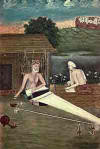|
|
the-south-asian.com July / August 2006 |
|
|||
|
August/September Contents
Sufis - wisdom against 50
years of mountain Heritage cities:
Cotton - the fibre of
|
|
||||
|
Cotton - the fibre of human civilisations Part ! of our in-depth report on Cotton Textile Industry of south Asia by Salman Minhas
Cotton is the Fibre of human civilizations. It was grown as far back as the time of the Peruvian Incas and Mexican-Indians, the Indus valley civilizations in South Asia along the banks of the river Indus, the Egyptian civilization along the Nile River and the Mesopotamian along the Tigris & Euphrates rivers in present day Iraq. Cotton has an ancient history. Fibres from circa 2200 B.C. have been discovered in the Indus Valley, and some from circa 2250 B.C. have turned up in Nubia, Egypt. Cottonseeds have also been discovered at Mehrgarh towards Quetta city in Pakistan, west of the Indus River. Cotton literally threads the fibres of our everyday lives. Millions of people, the world over, use cotton clothing, towels, shirts, bed-sheets and pillow covers to start and end their day. The earliest documentation of woven fabric in the Indian subcontinent is found on the sculpted bust of King-Priest of Mohenjo Daro-Indus Valley Civilization-2200-1800 B.C.The 3 sun shaped discs "Trefoil" show the unity of sun earth & water gods .This shawl pattern is still reproduced today in Sindh , Pakistan. The same trefoil was found on the Hathor cow and on the bodies of Sumerian bulls in Mesopotamia. The word cotton is from the Arabic "al-qattan" . The Sanskrit word for cotton is Karpasa. The Greek word Karpasos and the Latin term Carbasus have evidently been derived from Sanskrit. It was only in 1607 that cotton was introduced to North America in Virginia. Cotton was called `"White Gold" and ‘King Cotton’ as it built the fortunes of farmers in North & South Carolina, Alabama, Louisiana, Georgia and Mississippi, on the backs of the infamous black slave labour. Later the use of Sea Island [extra long staple cotton –ELS- greater than 1.3 inches long] and "Upland" cotton made USA one of the largest cotton producers in the world along with China, India, Pakistan and Uzbekistan. The ancient Indian magnum opus Vedas, show a time in the Atharva Veda where one of its passages personifies day and night as two sisters weaving. The warp symbolized darkness, and the woof symbolized light. The sacred place that thread and weaving held is illustrated in many hymns of the Vedas. The Hindi-Urdu words for warp & weft are Tana and Bana. (Warp = Vertical thread wound on a Roller. The Woof=Weft = thread at right angles to the Warp/ Horizontal Thread.) Buddhist literature chronicles the work of the skilled weavers and spinners of Kashi who excelled in fine muslin, so fine that oil could not seep through. It was women who spun, and the cotton cloths were washed, calendered, starched and perfumed. Fine cotton muslin was used to wrap the bodies of emperors and also the Buddha when he attained enlightenment nirvana. The woven cloth, textile design and iconography in early India was based on the principles of different Vedas - hence the trefoil motif of the King Priest from Mohenjodaro showing the unity of sun, earth, and water gods. The mystique of the weaver is rooted in custom and ritual of religion. This created a relationship between him and the cloth that he wove. The cosmos, the ordered Universe, was seen as an endless and continuous fabric with its grid pattern of warp and woof over which is painted life in all its cycles, illusions and dreams. In the olden times when weaving was done manually, the Master weaver was celebrated as an artist, a musician, and his loom an instrument of music. He memorized the patterns. The raga was established as he threw the shuttle through the tautly stretched warp threads, back and forth, over and over again. He beat the warp rhythmically, keeping taal. The wooden pedal was depressed to synchronize the throwing of the shuttles. In India, the Brahmins wore mostly white cottons; the Kshatriyas [warriors] wore shades of red and the Vaishyas [working class] yellow and bright colours. It is said the south-Indian Chola princes [1000-1100] wore only cotton. The king's robe was of quilted cotton, with gold thread woven in. Chola soldiers also used quilted cotton fabrics. The
weavers were called "Julahas" . However one of the greatest Sufi /Bhakti
poets was
The Sari is the garment of choice for 75% of the female population (now close to one billion), of the Indian sub-continent, due to its versatility. This unstitched piece of cloth, with the aid of manual skill, can be worn like a gown, a skirt, trousers, and even shorts. If women have stolen many hearts wearing the sari like a regal gown, they have also fought many wars on horsebacks, and conquered their enemies, wearing it in a trouser like fashion! Psychologist Carl Jung has waxed lyrical about the elegance of the sari : "It would be a loss to the whole world if the Indian woman should cease to wear her native costume. India is practically the only civilized country where one can see on living models how woman can and should dress". See http://www.the-south-asian.com/Past%20articles/Back-issues_by_subject_4.htm It is said that that when Amrapali, a courtesan from the kingdom of Vaishali met Gautam Buddha, she wore a richly woven semi transparent sari, which speaks volumes of the technical achievement of the ancient Indian weaver. Incidentally Amrapali is the name also of a famous mango, because the courtesan donated her mango orchards to the Buddha’s order. Legend also has it that when Lord Budhha attained Nirvana, his mortal remains were wrapped in a Banarasi material i.e. brocade which radiated dazzling lights of yellow, red and blue. Under early and late Mughal court patronage [1500-1800], the city of Dacca and ancient Sonargaon’s cotton weavers achieved a perfection that has probably never been equaled in the history of human textile making. The history of Bengal muslin may be in fact much earlier than this; some claim it has existed since 700 B.C. The wispy delicacy of Dacca muslins ["mal mal"] were some of the finest examples of Dacca’s products. The Mughal emperor Aurangzeb (reign 1658-1707) was reportedly angry with his daughter for wearing an immodest sheer/ see-through muslin sari. The young princess justified her sari by replying that she was wrapped in seven layers of fabric! Bengali Dacca Muslins: The "Jamdani" saris or the figured muslins are amongst the most exclusive of Dacca muslins. Dacca Muslins had exotic & poetic names such as "Shabnam" (morning/ evening dew), "Mal Mal khaas" (special muslin reserved for kings) and "Abrawan" (flowing water). These muslins, when stretched on the grass and drenched with dew would become invisible because of their fragile transparency. The base fabric for Jamadanis is unbleached cotton yarn and the design is woven using bleached cotton yarns so that a light-and-dark effect is created. As far back as 327 BC, Alexander the Great mentions "beautiful printed cottons" in India. Roman emperors paid fabulous sums for the prized Indian cotton, which was known as mal mal khaas. The word "Jamdani" comes from the Persian word 'jama', means cloth and 'dana', which means grain or buti or diapering. Jamdani therefore could mean diapered cloth. It is probable that Muslims introduced jamdani weaving and the industry was their monopoly for a long time. Kautilya, the great Political Scholar in the hey-days of Taxila [ now near Islamabad] in his book of economics (about 300 AD) mentions Jamdani cloth and states that this fine cloth used to be made in Bengal and Pundranagara the earliest urban center in Bangladesh, the antiquity of which goes back to the 4th century BC. Mention is also found in the book of Periplus of the Eritrean Sea and in the accounts of Arab, Chinese and Italian travelers and traders. Four kinds of fine cloth used to be made in Bengal and Pundra in those days, that is khouma, dukul, pattrorna and karpasi. For a brief period of history of about 100 years, between 1850 and 1920, the Indian Master weavers and handloom craftsmen suffered a decline due to British colonial policies of sending the cotton from India back to Lancashire and Manchester textile mills. India has led the return to Handloom weaving with its large village population base of craftsmen. Mahatama Gandhi famously led this charge. There has been a complete rebirth of India’s handloom industry of which we shall present in a later article. It was perhaps a great irony of history that the opening up of the sea routes by the Europeans such as Vasco Da Gama would lead to the domination of Textiles in Europe by the Indian textile industry. Follow our trail of cotton from India to the global fashion ramps in the next issue *****
|
|||||
|
Copyright © 2000 - 2006 [the-south-asian.com]. Intellectual Property. All rights reserved. |
|||||


